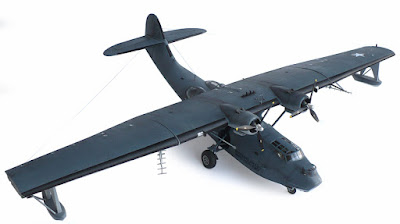Here are some more images of Monograms 1/48 scale Consolidated PBY-5 Catalina
reconnaissance and rescue aircraft. The markings on this aircraft are
that of Admiral John McCain. No not the "my friends" John McCain but his
old man.
From Wikipedia"
The Consolidated PBY Catalina was an American flying boat of the 1930s and 1940s produced by Consolidated Aircraft. It was one of the most widely used multi-role aircraft of World War II. PBYs served with every branch of the US military and in the air forces and navies of many other nations. In the United States Army Air Forces and later in the United States Air Force their designation was the OA-10, while Canadian-built PBYs were known as the Canso.
During World War II, PBYs were used in anti-submarine warfare, patrol bombing, convoy escorts, search and rescue missions (especially air-sea rescue), and cargo transport.
The PBY was the most successful aircraft of its kind; no other flying
boat was produced in greater numbers. The last active military PBYs
were not retired from service until the 1980s. Even today, over 70
years after its first flight, the aircraft continues to fly as an
airtanker in aerial firefighting operations all over the world.
The initialism of "P.B.Y." was determined in accordance with the U.S. Navy aircraft designation system of 1922; PB representing "Patrol Bomber" and Y being the code used for the aircraft's manufacturer, Consolidated Aircraft.
As American dominance in the Pacific Ocean began to face competition from Japan in the 1930s, the U.S. Navy contracted Consolidated Aircraft and Douglas Aircraft Corporation in October 1933 to build competing prototypes for a patrol flying boat.
Naval doctrine of the 1930s and 1940s used flying boats in a wide
variety of roles that today are handled by multiple special-purpose
aircraft. The US Navy had adopted the Consolidated P2Y and Martin P3M
models for this role in 1931, but both aircraft proved to be
underpowered and hampered by short ranges and low maximum payloads.
Consolidated and Douglas both delivered single prototypes of their designs, the XP3Y-1 and XP3D-1,
respectively. Consolidated's XP3Y-1 was an evolution of the XPY-1
design that had originally competed unsuccessfully for the P3M contract
two years earlier and of the XP2Y design that the Navy had authorized
for a limited production run. Although the Douglas aircraft was a good
design, the Navy opted for Consolidated's because the projected cost was
only $90,000 per aircraft.
Consolidated's XP3Y-1 design (company Model 28) was revolutionary in a number of ways. The aircraft had a parasol wing with internal bracing that allowed the wing to be a virtual cantilever, except for two small streamlined
struts on each side. Stabilizing floats, retractable in flight to form
streamlined wingtips, were another aerodynamic innovation, a feature
licensed from the Saunders-Roe company. The two-step hull design was similar to that of the P2Y, but the Model 28 had a cantilever cruciform tail unit instead of a strut-braced twin tail. Cleaner aerodynamics gave the Model 28 better performance than earlier designs.
The prototype was powered by two 825 hp (615 kW) Pratt & Whitney R-1830-54 Twin Wasp engines mounted on the wing’s leading edges. Armament comprised four 0.30 in (7.62 mm) Browning machineguns and up to 2,000 lb (907 kg) of bombs.
The
XP3Y-1 had its maiden flight on 28 March 1935, after which it was
transferred to the US Navy for service trials. The XP3Y-1 soon proved
to have significant performance improvements over current patrol flying
boats. The Navy requested further development in order to bring the
aircraft into the category of patrol bomber, and in October 1935,
the prototype was returned to Consolidated for further work, including
installation of 900 hp (671 kW) R-1830-64 engines. For the
redesignated XPBY-1, Consolidated introduced redesigned vertical tail
surfaces. The XPBY-1 had its maiden flight on 19 May 1936, during which
a record non-stop distance flight of 3,443 miles (5,541 km) was
achieved.
The XPBY-1 was delivered to VP-11F in October 1936. The second squadron to be equipped was VP-12,
which received the first of its aircraft in early 1937. The second
production order was placed on 25 July 1936. Over the next three years,
the PBY design was gradually developed further and successive models
introduced.








No comments:
Post a Comment